COM 441 Homework: Public Relations, Journalism, Ethics & Models
VerifiedAdded on 2023/06/03
|5
|981
|126
Homework Assignment
AI Summary
This assignment provides a comprehensive analysis of public relations, contrasting it with journalism, advertising, and marketing. It discusses the Boston Tea Party as a publicity stunt and examines the role of student demonstrations in raising awareness for gun control and mental health issues, relating these actions to the agenda-setting theory. Furthermore, the assignment outlines and describes Grunig and Hunt's four models of public relations, associating each with a relevant pioneer. Finally, it addresses ethical considerations within PR, specifically regarding transparency and honesty in product reviews, and advocating for ethical practices in engaging with the public. The assignment emphasizes the importance of factual information and genuine experiences in shaping public perception.
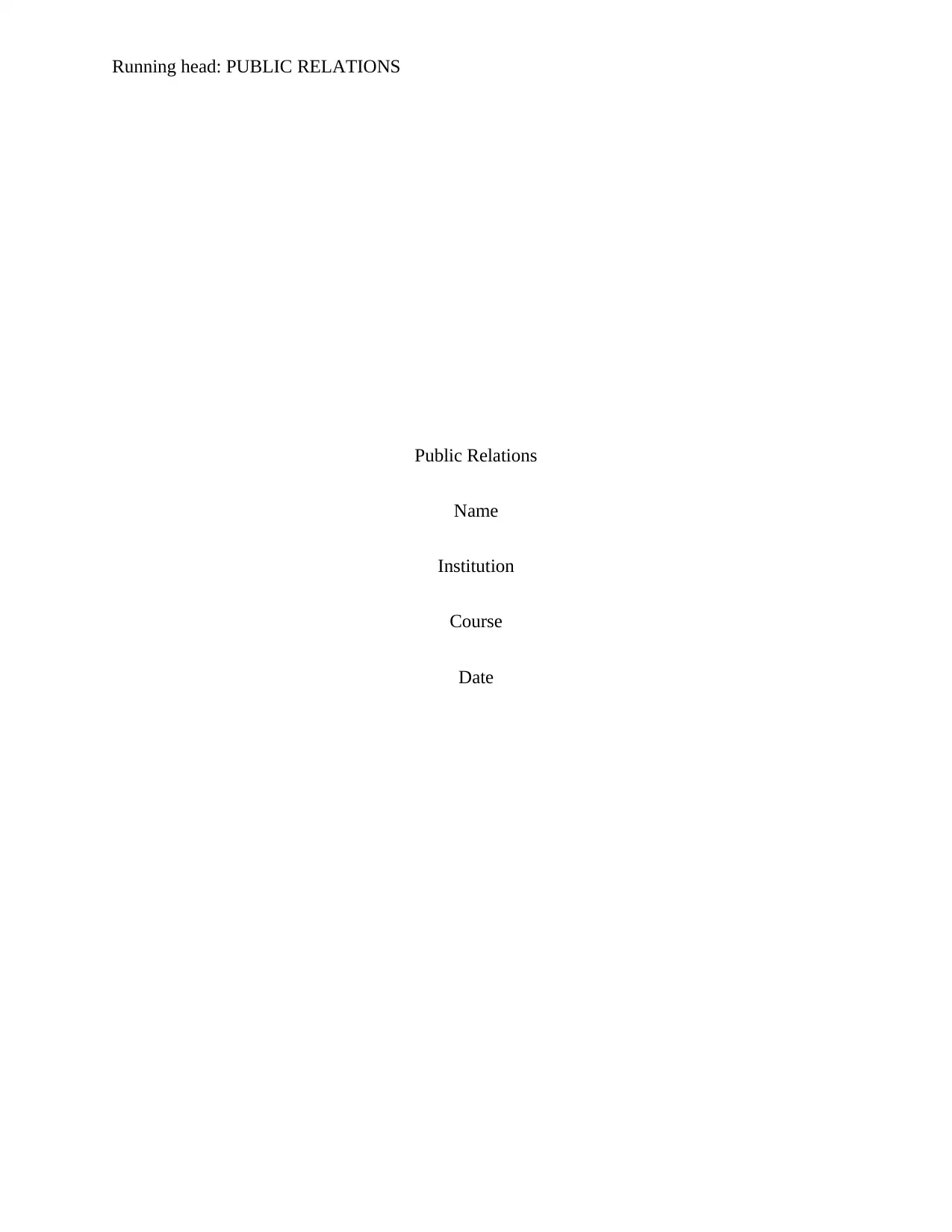
Running head: PUBLIC RELATIONS
Public Relations
Name
Institution
Course
Date
Public Relations
Name
Institution
Course
Date
Paraphrase This Document
Need a fresh take? Get an instant paraphrase of this document with our AI Paraphraser
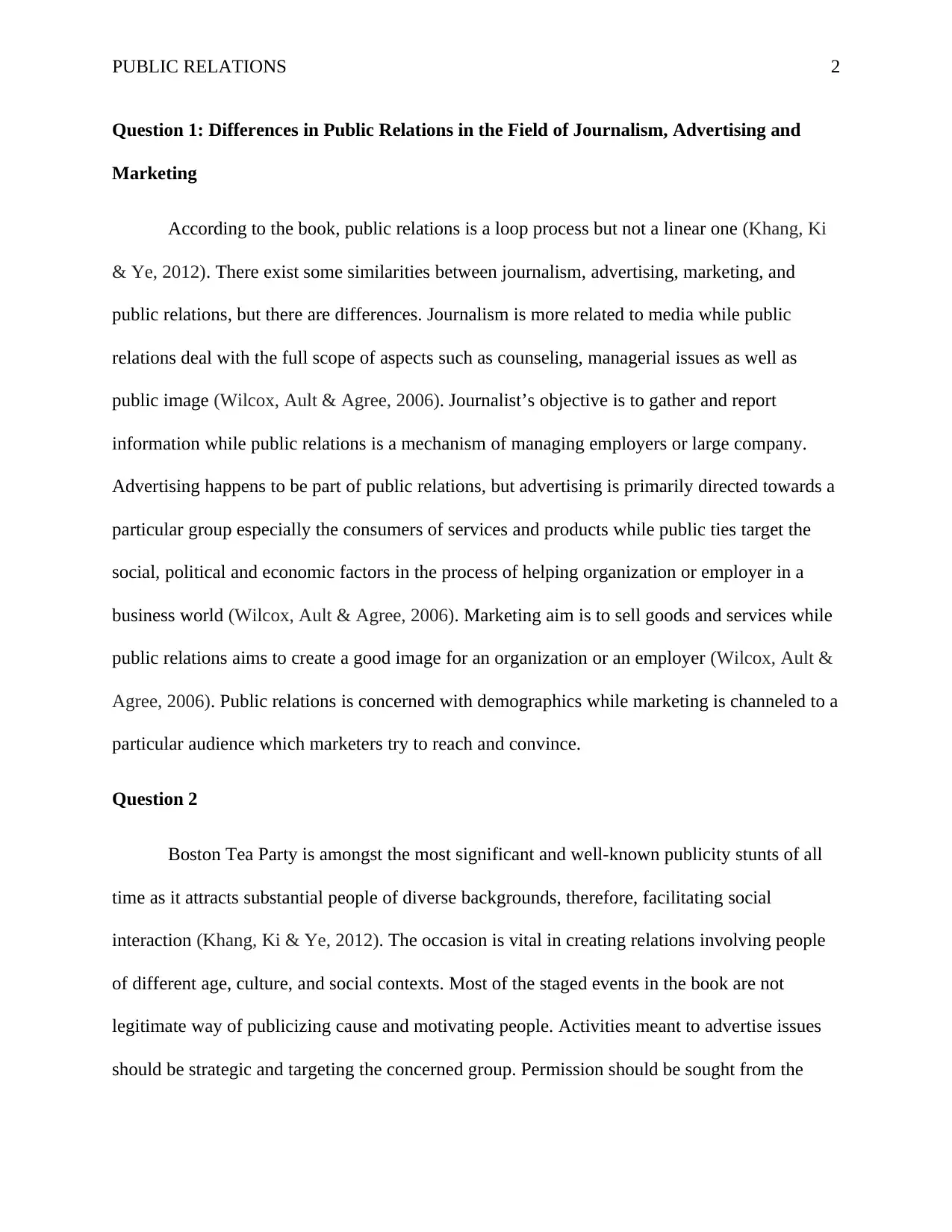
PUBLIC RELATIONS 2
Question 1: Differences in Public Relations in the Field of Journalism, Advertising and
Marketing
According to the book, public relations is a loop process but not a linear one (Khang, Ki
& Ye, 2012). There exist some similarities between journalism, advertising, marketing, and
public relations, but there are differences. Journalism is more related to media while public
relations deal with the full scope of aspects such as counseling, managerial issues as well as
public image (Wilcox, Ault & Agree, 2006). Journalist’s objective is to gather and report
information while public relations is a mechanism of managing employers or large company.
Advertising happens to be part of public relations, but advertising is primarily directed towards a
particular group especially the consumers of services and products while public ties target the
social, political and economic factors in the process of helping organization or employer in a
business world (Wilcox, Ault & Agree, 2006). Marketing aim is to sell goods and services while
public relations aims to create a good image for an organization or an employer (Wilcox, Ault &
Agree, 2006). Public relations is concerned with demographics while marketing is channeled to a
particular audience which marketers try to reach and convince.
Question 2
Boston Tea Party is amongst the most significant and well-known publicity stunts of all
time as it attracts substantial people of diverse backgrounds, therefore, facilitating social
interaction (Khang, Ki & Ye, 2012). The occasion is vital in creating relations involving people
of different age, culture, and social contexts. Most of the staged events in the book are not
legitimate way of publicizing cause and motivating people. Activities meant to advertise issues
should be strategic and targeting the concerned group. Permission should be sought from the
Question 1: Differences in Public Relations in the Field of Journalism, Advertising and
Marketing
According to the book, public relations is a loop process but not a linear one (Khang, Ki
& Ye, 2012). There exist some similarities between journalism, advertising, marketing, and
public relations, but there are differences. Journalism is more related to media while public
relations deal with the full scope of aspects such as counseling, managerial issues as well as
public image (Wilcox, Ault & Agree, 2006). Journalist’s objective is to gather and report
information while public relations is a mechanism of managing employers or large company.
Advertising happens to be part of public relations, but advertising is primarily directed towards a
particular group especially the consumers of services and products while public ties target the
social, political and economic factors in the process of helping organization or employer in a
business world (Wilcox, Ault & Agree, 2006). Marketing aim is to sell goods and services while
public relations aims to create a good image for an organization or an employer (Wilcox, Ault &
Agree, 2006). Public relations is concerned with demographics while marketing is channeled to a
particular audience which marketers try to reach and convince.
Question 2
Boston Tea Party is amongst the most significant and well-known publicity stunts of all
time as it attracts substantial people of diverse backgrounds, therefore, facilitating social
interaction (Khang, Ki & Ye, 2012). The occasion is vital in creating relations involving people
of different age, culture, and social contexts. Most of the staged events in the book are not
legitimate way of publicizing cause and motivating people. Activities meant to advertise issues
should be strategic and targeting the concerned group. Permission should be sought from the
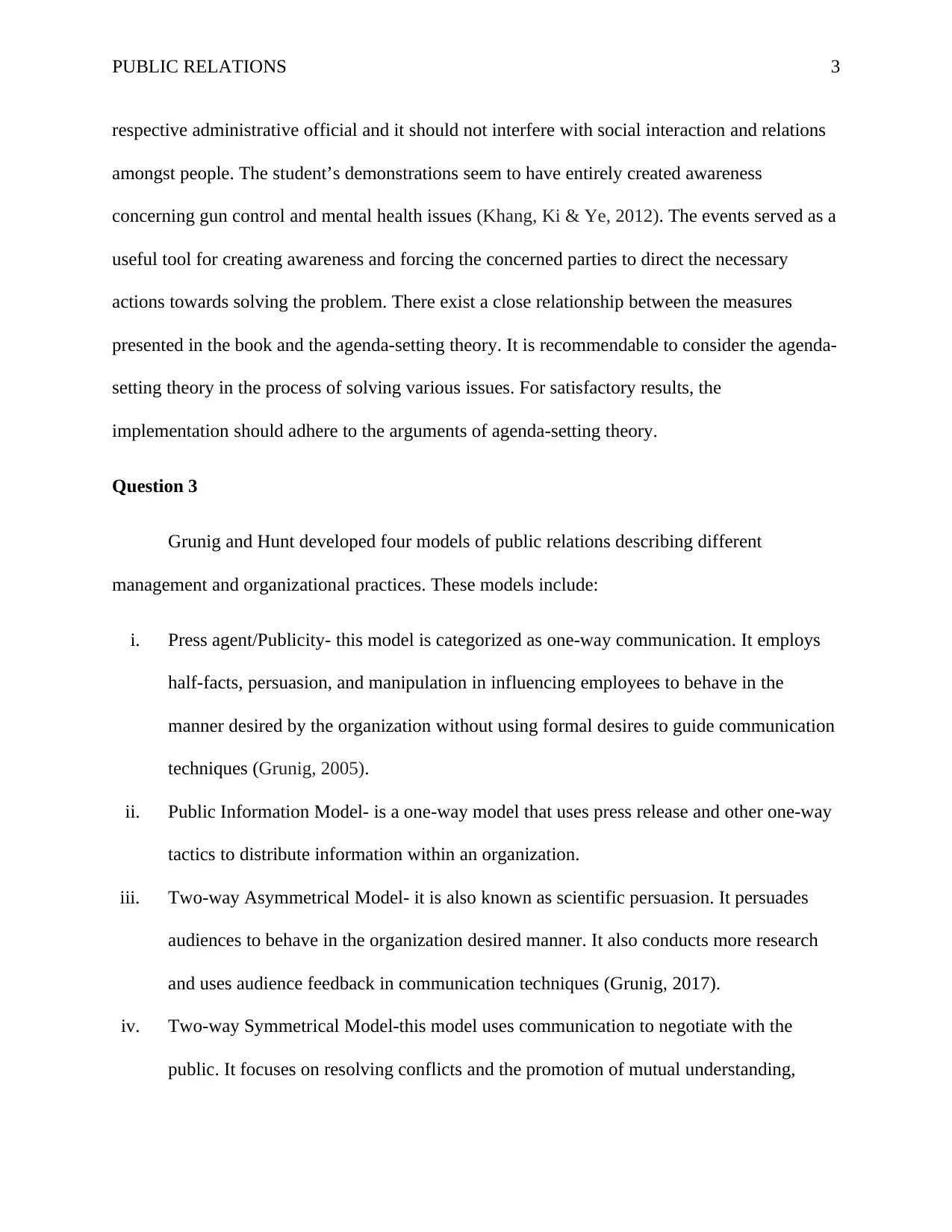
PUBLIC RELATIONS 3
respective administrative official and it should not interfere with social interaction and relations
amongst people. The student’s demonstrations seem to have entirely created awareness
concerning gun control and mental health issues (Khang, Ki & Ye, 2012). The events served as a
useful tool for creating awareness and forcing the concerned parties to direct the necessary
actions towards solving the problem. There exist a close relationship between the measures
presented in the book and the agenda-setting theory. It is recommendable to consider the agenda-
setting theory in the process of solving various issues. For satisfactory results, the
implementation should adhere to the arguments of agenda-setting theory.
Question 3
Grunig and Hunt developed four models of public relations describing different
management and organizational practices. These models include:
i. Press agent/Publicity- this model is categorized as one-way communication. It employs
half-facts, persuasion, and manipulation in influencing employees to behave in the
manner desired by the organization without using formal desires to guide communication
techniques (Grunig, 2005).
ii. Public Information Model- is a one-way model that uses press release and other one-way
tactics to distribute information within an organization.
iii. Two-way Asymmetrical Model- it is also known as scientific persuasion. It persuades
audiences to behave in the organization desired manner. It also conducts more research
and uses audience feedback in communication techniques (Grunig, 2017).
iv. Two-way Symmetrical Model-this model uses communication to negotiate with the
public. It focuses on resolving conflicts and the promotion of mutual understanding,
respective administrative official and it should not interfere with social interaction and relations
amongst people. The student’s demonstrations seem to have entirely created awareness
concerning gun control and mental health issues (Khang, Ki & Ye, 2012). The events served as a
useful tool for creating awareness and forcing the concerned parties to direct the necessary
actions towards solving the problem. There exist a close relationship between the measures
presented in the book and the agenda-setting theory. It is recommendable to consider the agenda-
setting theory in the process of solving various issues. For satisfactory results, the
implementation should adhere to the arguments of agenda-setting theory.
Question 3
Grunig and Hunt developed four models of public relations describing different
management and organizational practices. These models include:
i. Press agent/Publicity- this model is categorized as one-way communication. It employs
half-facts, persuasion, and manipulation in influencing employees to behave in the
manner desired by the organization without using formal desires to guide communication
techniques (Grunig, 2005).
ii. Public Information Model- is a one-way model that uses press release and other one-way
tactics to distribute information within an organization.
iii. Two-way Asymmetrical Model- it is also known as scientific persuasion. It persuades
audiences to behave in the organization desired manner. It also conducts more research
and uses audience feedback in communication techniques (Grunig, 2017).
iv. Two-way Symmetrical Model-this model uses communication to negotiate with the
public. It focuses on resolving conflicts and the promotion of mutual understanding,
⊘ This is a preview!⊘
Do you want full access?
Subscribe today to unlock all pages.

Trusted by 1+ million students worldwide
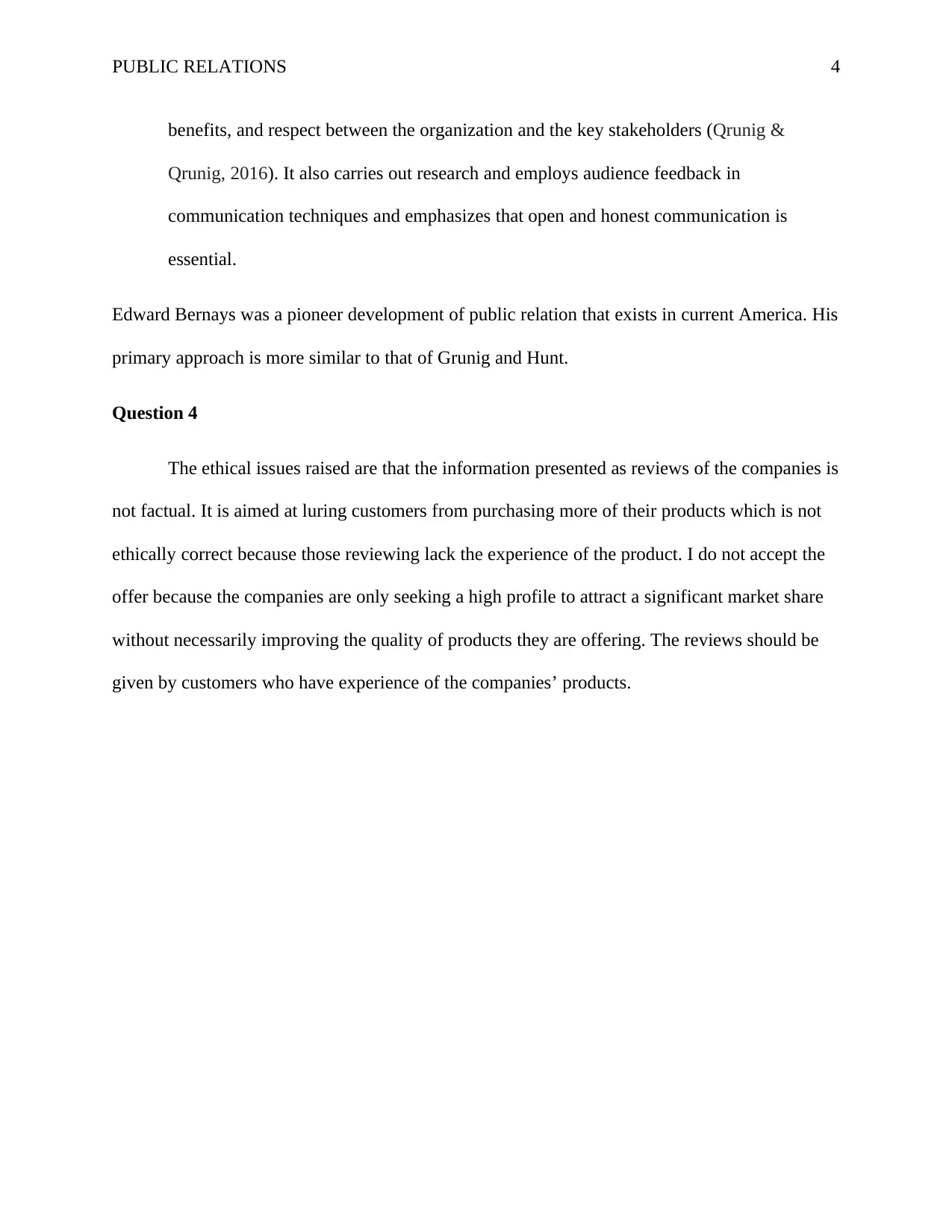
PUBLIC RELATIONS 4
benefits, and respect between the organization and the key stakeholders (Qrunig &
Qrunig, 2016). It also carries out research and employs audience feedback in
communication techniques and emphasizes that open and honest communication is
essential.
Edward Bernays was a pioneer development of public relation that exists in current America. His
primary approach is more similar to that of Grunig and Hunt.
Question 4
The ethical issues raised are that the information presented as reviews of the companies is
not factual. It is aimed at luring customers from purchasing more of their products which is not
ethically correct because those reviewing lack the experience of the product. I do not accept the
offer because the companies are only seeking a high profile to attract a significant market share
without necessarily improving the quality of products they are offering. The reviews should be
given by customers who have experience of the companies’ products.
benefits, and respect between the organization and the key stakeholders (Qrunig &
Qrunig, 2016). It also carries out research and employs audience feedback in
communication techniques and emphasizes that open and honest communication is
essential.
Edward Bernays was a pioneer development of public relation that exists in current America. His
primary approach is more similar to that of Grunig and Hunt.
Question 4
The ethical issues raised are that the information presented as reviews of the companies is
not factual. It is aimed at luring customers from purchasing more of their products which is not
ethically correct because those reviewing lack the experience of the product. I do not accept the
offer because the companies are only seeking a high profile to attract a significant market share
without necessarily improving the quality of products they are offering. The reviews should be
given by customers who have experience of the companies’ products.
Paraphrase This Document
Need a fresh take? Get an instant paraphrase of this document with our AI Paraphraser
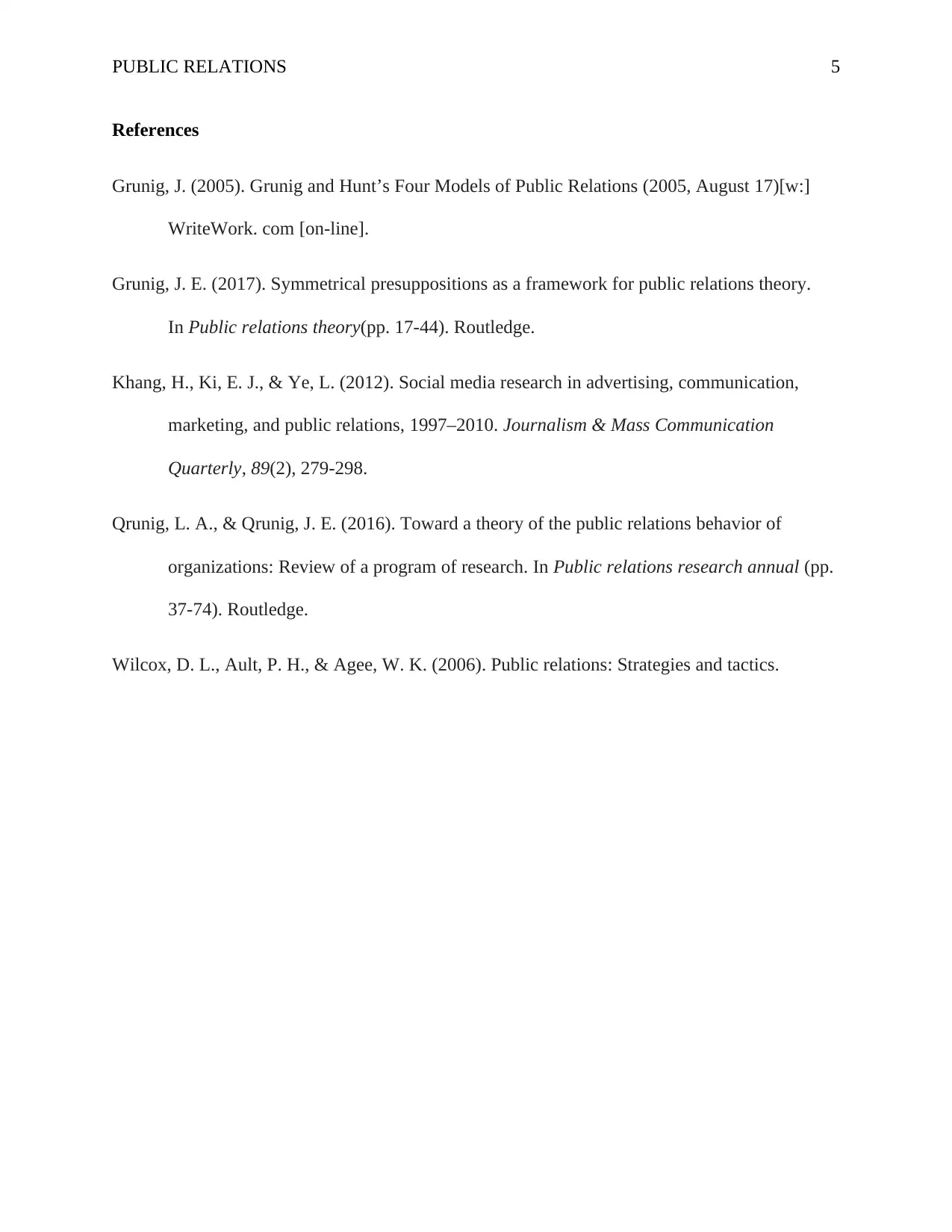
PUBLIC RELATIONS 5
References
Grunig, J. (2005). Grunig and Hunt’s Four Models of Public Relations (2005, August 17)[w:]
WriteWork. com [on-line].
Grunig, J. E. (2017). Symmetrical presuppositions as a framework for public relations theory.
In Public relations theory(pp. 17-44). Routledge.
Khang, H., Ki, E. J., & Ye, L. (2012). Social media research in advertising, communication,
marketing, and public relations, 1997–2010. Journalism & Mass Communication
Quarterly, 89(2), 279-298.
Qrunig, L. A., & Qrunig, J. E. (2016). Toward a theory of the public relations behavior of
organizations: Review of a program of research. In Public relations research annual (pp.
37-74). Routledge.
Wilcox, D. L., Ault, P. H., & Agee, W. K. (2006). Public relations: Strategies and tactics.
References
Grunig, J. (2005). Grunig and Hunt’s Four Models of Public Relations (2005, August 17)[w:]
WriteWork. com [on-line].
Grunig, J. E. (2017). Symmetrical presuppositions as a framework for public relations theory.
In Public relations theory(pp. 17-44). Routledge.
Khang, H., Ki, E. J., & Ye, L. (2012). Social media research in advertising, communication,
marketing, and public relations, 1997–2010. Journalism & Mass Communication
Quarterly, 89(2), 279-298.
Qrunig, L. A., & Qrunig, J. E. (2016). Toward a theory of the public relations behavior of
organizations: Review of a program of research. In Public relations research annual (pp.
37-74). Routledge.
Wilcox, D. L., Ault, P. H., & Agee, W. K. (2006). Public relations: Strategies and tactics.
1 out of 5
Your All-in-One AI-Powered Toolkit for Academic Success.
+13062052269
info@desklib.com
Available 24*7 on WhatsApp / Email
![[object Object]](/_next/static/media/star-bottom.7253800d.svg)
Unlock your academic potential
Copyright © 2020–2025 A2Z Services. All Rights Reserved. Developed and managed by ZUCOL.
